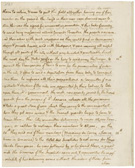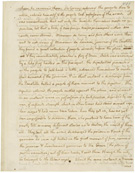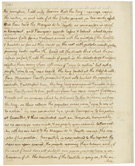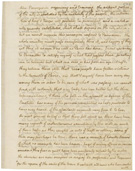Thomas Jefferson - Onset of the French Revolution, 1789
“Nothing can be believed
but what one sees, or has
from an eye witness.”
—Thomas Jefferson, July 19, 1789
Appointed U.S. Minister to France in 1785, Thomas Jefferson was the American Government’s man on the ground in Paris in July 1789 when the French people rose up against their rulers and the first blood was shed in the opening days of the French Revolution. Author of the Declaration of Independence whose immortal words had come to define the spirit of the Revolution in America, Jefferson followed closely and with great interest the events of the unfolding Revolution in France.
In 1789, when King Louis XVI summoned the States General, an assembly of nobles, clergy, and citizens that had not convened since 1614, to address a huge financial crisis, Jefferson commuted daily from his lavish house on the outskirts of the city to Versailles to observe the meetings being held there. And in July, when the streets of Paris descended into lawlessness, chaos, and violence, Jefferson and his secretary, William Short, roamed the streets to learn firsthand what was happening.
The storming of the Bastille, the public beheading of its director, a dramatic appearance of the King—these monumental events, clouded by the chaos and uncertainty of the moment—are all told in the calm, clear voice of America’s Thomas Jefferson.
Letter from Thomas Jefferson, U.S. Minister to France, to John Jay, Secretary of Foreign Affairs, July 19, 1789, reporting on the events in Paris, page 537
This portion of Jefferson’s twelve-page letter—written entirely in his own hand—recounts how a mob seeking to arm themselves, stormed the Bastille (the fourteenth-century fortress used as a prison), took the stash of arms, freed the prisoners, and seized the “Governor” of the Bastille who was then killed and beheaded in the city streets. A later portion of the letter recounts the panic at the King’s court at Versailles resulting from false reports that a mob of 150,000 was on their way to “massacre the Royal family, the court, the ministers and all connected with them.”
National Archives, Records of the Continental and Confederation Congresses and the Constitutional Convention
Excerpt:
“The people now armed themselves with such weapons as they could find in Armourer’s shops & private houses, and with bludgeons, & were roaming all night through all parts of the city without any decided & practicable object.”
—From Thomas Jefferson’s letter
.
Letter from Thomas Jefferson, U.S. Minister to France, to John Jay, Secretary of Foreign Affairs, July 19, 1789, reporting on the events in Paris, page 538
This portion of Jefferson’s twelve-page letter—written entirely in his own hand— recounts how a mob seeking to arm themselves, stormed the Bastille (the fourteenth-century fortress used as a prison), took the stash of arms, freed the prisoners, and seized the “Governor” of the Bastille who was then killed and beheaded in the city streets. A later portion of the letter recounts the panic at the King’s court at Versailles resulting from false reports that a mob of 150,000 was on their way to “massacre the Royal family, the court, the ministers and all connected with them.”
National Archives, Records of the Continental and Confederation Congresses and the Constitutional Convention
Excerpt:
“[At the Bastille] They took all the arms, discharged the prisoners & such of the garrison as were not killed in the first moment of fury, carried the Governor & Lieutenant governor to the Greve (the place of public execution) cut off their heads, & sent them through the city in triumph to the Palais royal.”
—From Thomas Jefferson’s letter
.
Letter from Thomas Jefferson, U.S. Minister to France, to John Jay, Secretary of Foreign Affairs, July 19, 1789, reporting on the events in Paris, page 541
This portion of Jefferson’s twelve-page letter—written entirely in his own hand—recounts how a mob seeking to arm themselves, stormed the Bastille (the fourteenth-century fortress used as a prison), took the stash of arms, freed the prisoners, and seized the “Governor” of the Bastille who was then killed and beheaded in the city streets. A later portion of the letter recounts the panic at the King’s court at Versailles resulting from false reports that a mob of 150,000 was on their way to “massacre the Royal family, the court, the ministers and all connected with them.”
National Archives, Records of the Continental and Confederation Congresses and the Constitutional Convention
Excerpt:
“[T]ranquillity [sic] is now restored to the Capital: the shops are again opened; the people resuming their labours, and, if the want of bread does not disturb our peace, we may hope a continuance of it.”
—From Thomas Jefferson’s letter
.
Letter from Thomas Jefferson, U.S. Minister to France, to John Jay, Secretary of Foreign Affairs, July 19, 1789, reporting on the events in Paris, page 542
This portion of Jefferson’s twelve-page letter—written entirely in his own hand—recounts how a mob seeking to arm themselves, stormed the Bastille (the fourteenth-century fortress used as a prison), took the stash of arms, freed the prisoners, and seized the “Governor” of the Bastille who was then killed and beheaded in the city streets. A later portion of the letter recounts the panic at the King’s court at Versailles resulting from false reports that a mob of 150,000 was on their way to “massacre the Royal family, the court, the ministers and all connected with them.”
National Archives, Records of the Continental and Confederation Congresses and the Constitutional Convention
Excerpt:
“I went yesterday to Versailles to satisfy myself what had passed there; for nothing can be believed but what one sees, or has from an eye witness. They believe there still that 3000 people have fallen victims to the tumults of Paris. Mr. Short & myself have been every day among them in order to be sure of what was passing. We cannot find with certainty that any body has been killed but the three beforementioned, & those who fell in the assault of defence of the Bastille. How many of the garrison were killed no body pretends to have ever heard. Of the assailants accounts vary from 6. to 600. The most general belief is that there fell about 30.”
—From Thomas Jefferson’s letter
.
Letter from Thomas Jefferson, U.S. Minister to France, to John Jay, Secretary of Foreign Affairs, July 19, 1789, reporting on the events in Paris, page 543
This portion of Jefferson’s twelve-page letter—written entirely in his own hand—recounts how a mob seeking to arm themselves, stormed the Bastille (the fourteenth-century fortress used as a prison), took the stash of arms, freed the prisoners, and seized the “Governor” of the Bastille who was then killed and beheaded in the city streets. A later portion of the letter recounts the panic at the King’s court at Versailles resulting from false reports that a mob of 150,000 was on their way to “massacre the Royal family, the court, the ministers and all connected with them.”
National Archives, Records of the Continental and Confederation Congresses and the Constitutional Convention
Excerpt:
“The churches are now occupied in singing ‘De profundis’ and ‘Requiem for the repose of the souls of the brave & valiant citizens who have sealed with their blood the liberty of the nation.’. . . I have the honor to be with great esteem & respect, Sir, your most obedient and most humble servt. Th. Jefferson”
—From Thomas Jefferson’s letter
.
Storming of the Bastille, July 14th, 1789, painting, unattributed, eighteenth century
The Bastille loomed large in the French imagination as a mysterious, medieval, dark dungeon of a place where vast numbers of people who had displeased the King would disappear to lead a tortured existence. In fact, by the time of Louis XVI, living conditions inside the Bastille were not at all dire; food was adequate, and prisoners were free to bring in many of their own possessions. On July 14, 1789, this towering symbol of royal oppression held only seven prisoners: two who were mentally ill, four forgers, and one person who had been incarcerated for incest.
Courtesy of Réunion des Musées Nationaux/Art Resource, NY
.
Thomas Jefferson, pencil on paper, unattributed, eighteenth century
Courtesy of The Maryland Historical Society, Baltimore, Maryland
.






